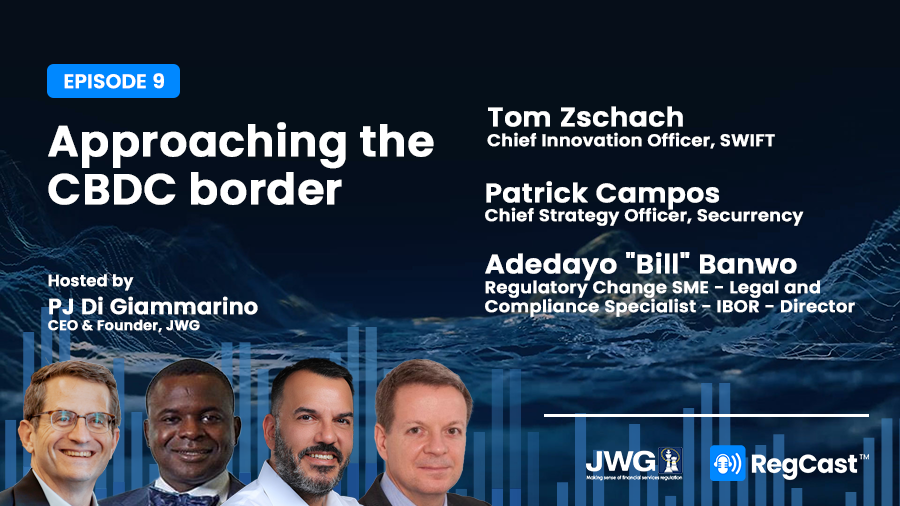Central Bank Digital Currencies (CBDCs) are now under central bankers’ microscopes as they explore ways to improve digital commerce, reinforce systemic resilience and preserve the foundational role of fiat money in global finance.
Emerging technology for digital identities, fraud detection and other elements of a robust payment solution can be a part of digital foundations for new systems that digitize complex cross-border payment systems.
However, a workable CBDC infrastructure will not emerge without international collaboration.
In this episode, Tom Zschach, Chief Innovation Officer, SWIFT, Patrick Campos, Chief Strategy Officer, Securrency and Bill Banwo. Former CFTC regulator and US public sector SME explore how close the industry is to CBDC becoming reality and what will it take for cross border CBDC payments to happen.
The Policy
We take away a need for crystal clear policy objectives for ‘programmable money’ right from the outset. There are many facets to CBDC which means depending on their use, the instrument can be defined differently.
In a nutshell, a common framework for the new policy objectives is required from the get-go in order to make them work across borders.
Experts advise that need for infrastructure to meet new objectives, like greater financial inclusion should be addressed in parallel to those objectives which can be met with current infrastructure standards.
The panel noted that there has been a lot of work in the past decade to improve the current financial infrastructure and the international oversight required to incorporate CBDCs is already there.
Implementation barriers and risks
According to a recent report by SWIFT and Accenture, “Exploring central bank digital currencies: How they could work for international payments”, Privacy, interoperability and social policy are areas where further work will be needed to introduce cross boarder CBDC.
Though we have the outline of the issues ahead, introduction of this new instrument also carries new risks. One example cited on this RegCast is the fact that new social and monetary ‘policy dials’ are being created which politicians and supervisors will be able to control.
‘Digital money’ could bring with it new political and economic risk for the system if authorities are able to ban an economic activity (e.g., gambling) or create an unlevel playing field for a preferred agent (e.g., religion).
Another key concern highlighted in this discussion is that digital money differs from physical in one key aspect: If there is an outage, it’s a much bigger issue than losing a car full of notes. New gatekeepers will need to monitor the CBDC infrastructures in order to maintain global confidence in the system.
For CBDCs to realise new policy aims, three key pieces of the infrastructure are required.
- Interoperability. Connectivity between new world and old-world infrastructure is foremost as little from the current payment infrastructure is likely to go away anytime soon.
- Privacy and security. The key for any network is to maintain the trust of the members.
- Scalability. The reliability and performance of the network must handle hundreds of billions with 99.99999% availability – a target most block chain systems struggle to meet today.
Could cross border CBDC infrastructure be the internet? Those that believe in decentralized controls will face a complicated roll-out path as the collaboration and standards required won’t be achieved overnight despite the obvious benefits.
The Prize
Is cross-border CBDC worth it? The experts lay out some compelling prizes. For those countries that have underbanked populations they can really increase the inclusiveness of the economy.
Another big benefit for the larger economies is upgrading the way we mange compliance. By digitizing the transaction, the ability to conduct much deeper, meaningful compliance checks can make life easier for the client and bring down the cost of services.
The most compelling prize identified in our discussion, however, was the economic benefits it can provide though more efficient and effective transactions on a larger network.
As the economy goes digital, payments can go digital and consumers and the corporate treasurer win by building inclusive networks which we can trust.
In all, CBDC presents a once in a lifetime opportunity rethink compliance in a better, faster and cheaper manner!)
Additional resources:
- To join JWG’s special interest groups (SIGs) email Stokes@jwg-it.eu
- To debate this topic, join JWG’s LinkedIn community here.
- To create your own JWG RegTech Hub sign-up here.
Materials
- Exploring central bank digital currencies: SWIFT and Accenture here
- Lael Brainard: Private money and central bank money as payments go digital – an update on CBDCs here
- Exploring central bank digital currencies: How they could work for international payments here
- Bitcoin mining is helping Iran avoid US sanctions Here
- Federal Reserve Chair Jerome H. Powell outlines the Federal Reserve’s response to technological advances driving rapid change in the global payments landscape here
- Aurora – a new dawn for Sterling with benefits for all here
- Bank of England statement on Central Bank Digital Currency here
- The real reason we need a digital euro here and EU here
- Do we need ‘public money’? here
- BIS: CPMI Enhancing cross-border payments: building blocks of a global roadmap here
- FSB Targets for Addressing the Four Challenges of Cross-Border Payments: Consultative document here
- BIS Central bank digital currency: the quest for minimally invasive technology here
- BIS CBDCs beyond borders: results from a survey of central banks here.
- BIS CBDCs: an opportunity for the monetary system here
- BIS project Jura here.
Available on all major podcast platforms, including:
Please feel free to subscribe and contact Corrina.stokes@jwg-it.eu with any feedback or if you would like to contribute to future episodes.





